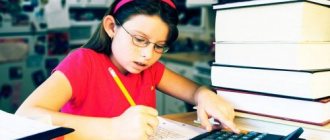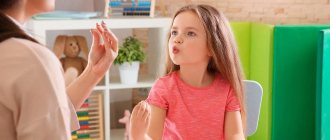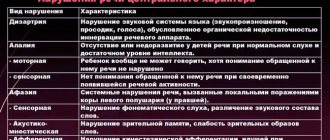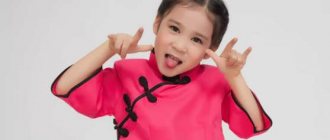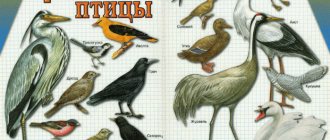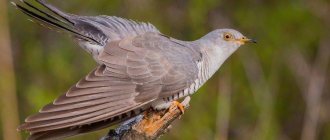Syllable tables. reading material (grade 1) on the topic
Letter C
Exercise 1.
Exercise:
- Read the first and then the second line of the table sequentially, clearly pronouncing the consonant S.
- Read the columns of the table selectively, clearly pronouncing all the vowels.
- Read selectively the lines of the table, lowering your voice to a whisper, then raising your voice.
- Find it among the table elements. Make words from two elements. Explain the meaning of these words.
Explanations: Us, sauce, ac.
| SA | CO | SU | SY | SI |
| AC | OS | US | YS | IP |
Exercise 2.
Exercise:
- Read the columns of the table sequentially.
- Read the rows of the table sequentially.
- Read the first three columns of the table, placing emphasis on the highlighted syllables.
- Read the given combination.
- Find words among letter combinations.
Explanations: Wasp, wasps, wasps, whiskers.
| ASA | ASO | WASP | USA | ISA | YSA |
| CCA | ACS | OSU | USO | ISO | YSO |
| USU | ASI | AXIS | USI | ISU | YSU |
| ISI | ASY | WASPES | MUSTACHE | ISY | YSI |
| SISES | SASA | SOSO | SUSU | SYSYS | Sisi |
| SASO | POSSA | SISY | SISES | SUSA | SUPPLES |
Answer the questions:
1. How are all the elements of the table similar? What is the difference?
Explanations: All elements of the table contain the consonant S.
All table elements consist of two syllables. Elements 5 and 6 of the line contain two consonants S. The elements of the table differ in vowels.
Exercise 3.
Exercise:
- Read the columns and rows of the table selectively, lowering and then raising your voice.
- Read selectively the rows (columns) of the table in one breath.
- Make words from the elements of the table.
Explanations: Sleighs, pumps, sauce, noses, sons, sleep, Nina, Inna, Anna.
| SA | CO | SU | SI | SY |
| ON | BUT | WELL | NI | WE |
| AC | OS | US | IP | YS |
| AN | HE | UN | IN | EUN |
Exercise 4.
Exercise:
- Read the columns of the table, highlighting the consonant N with your voice.
- Read the lines of the table, pronouncing the vowel sounds clearly.
- Read the second line of the table with the emphasis on the highlighted vowels.
| NAS | NON | NON | NIN | NUN |
| ANAS | NONO | NYNY | NO NO | OH WELL |
| ANNA | ONNO | EUNNY | INNI | UNNU |
| ACCA | OSSO | YSSY | ISSI | USSU |
| ANAN | ONON | EUNEUNG | ININ | UNUN |
| ACAS | OSOS | YSYS | ISIS | USUS |
Answer the questions:
- What do the elements in the fourth row of the table have in common?
- How are the elements of the third column of the table different?
- Name a combination in which the soft consonant [Н`] is heard twice.
- Name combinations in which the hard consonant [H] is heard twice.
Explanations: All elements of the fourth row contain a double letter C. All elements of the third column contain the vowel І, but differ in consonants. [Н`] is heard twice in the combination NINI. [N] is heard twice in the combination NYNY, NANA, NONO, NUNU, UNUN, ANAN, ONON, NYNY, UNUN.
Exercise 5.
Task 1: Find in each row of the table the element corresponding to the one highlighted in the first column.
How are all table elements similar?
What is the difference?
| WASP | ASA | WASP | CCA | ASA |
| AXIS | ISO | CCA | AXIS | ISI |
| WASPES | WASPES | YSO | YSY | CCA |
| MUSTACHE | MUSTACHE | USI | USO | USA |
Explanations: All elements of the table consist of two syllables, as they include two vowels. Among the elements of the table, we can distinguish words (see the first column), each of them has its own meaning, and combinations of letters (oso, yso, ysy, etc.), which have no lexical meaning.
Task 2: Find the word among similar combinations of letters.
| ANNA | ANAN ANAN NANA ANNA |
| NINA | INNA NANI NINA ANNIE |
| SLED | SINA SANI NASI SAIN |
| SAUCE | SUOS SOSU SAUCE SUSO |
| A PINEAPPLE | PINEAPPLE ANSANA NASSA SANANAS |
| PUMP | NOSAS NASAS PUMP NASAS |
How to speed up the process of improving reading skills
Syllable tables for preschool children have different variations - from simple to complex. It is important to monitor how the material is being absorbed and to avoid gaps in knowledge; it may take twice as long to learn a single letter or syllable, but the skill needs to be consolidated.
You need to work not only with tables, you can select short phrases and stories so that the child understands that words form a text that makes sense. It is better to place the aids in the child’s work area so that in case of difficulties there is always a hint.
Syllable tables intended for preschoolers can be studied using any method convenient for the child. Teachers often combine several methods and choose easier-to-understand options. In addition to the main table, it is recommended to use auxiliary aids in the form of cards or cubes.
Fusion syllables are...
Fusion syllables are usually called combinations of two letters, where the first is always a consonant, and the second is a vowel or a soft sign: “NA”, “PA”, “RE”, “SO”, “Ть”, “Сь”. In fact, each word is a combination of individual letters and merging syllables: “KA-SHA”, “LO-ZH-KA”, “PO-TO-LO-K”. Syllable fusion is a mandatory element of the word reading technique.
To learn to read, you need:
- know all the letters and their corresponding sounds;
- know the direction from where and where to read (from left to right);
- know the fusion syllables characteristic of the language and pronounce them correctly;
- learn to break words into merged syllables and individual letters.
Everyone has heard the expression “read by syllables,” or, as they used to say, “by words.” It was by folding “Az” and “Buki” (“ABC”) that children were taught to read until the nineteenth century. The syllables had to be memorized by heart. But the approach to studying them was too complicated and the methodology was abandoned for some time.
Today, the method of reading by warehouses has been improved and refined. N. A. Zaitsev. The brilliant Russian teacher took ordinary cubes as a basis and placed a letter or word on each side. By learning to read in this way, children do not have difficulty merging individual letters and form words with ease.
Techniques
Mastering merging syllables can be achieved in different ways. The first one that comes to mind is to sequentially learn letters, then syllables, and only then start reading words. This method is simple for the teacher, but difficult for the child. The fact is that the 33 letters of the Russian alphabet form close to 200 variant pairs.
Table:
The child will have to cram them, for a long time, and without understanding why it is needed. Of course, this will kill the desire to learn in the bud.
The most convenient and easiest way to master merging syllables is to learn them gradually and together with letters, according to the principle - from the most common and easy to pronounce to the most complex. That is, according to the ABC book.
It is recommended to start studying with the letter “N” (after becoming familiar with vowels). Namely, master its writing, learn to recognize by ear the different parts of a word, determine the soft and hard form. At the next stage, you need to substitute cards with vowels and name the syllables “NA”, “NI”, “WELL”, “NO”. Only after this the child will be able to compose and read the word (“NO-S”, “O-NA”, “NI-Z”, “NI-NA”), using various reading schemes.
As new letters are introduced, new groups of merging syllables will appear. They should be studied separately and in combination with those already studied.
Print out a table with merging syllables and place it on your child’s desk. Gradually he will get used to it and begin to navigate well, find and read the right pair. This is a very useful skill that will make studying easier now and in the future.
Letter T tasks for preschoolers with pictures
Purpose of the lesson: we study the letter T, the formation of reading skills, the development of speech skills, the improvement of phonemic awareness, the basics of elementary graphic skills.
Tasks:
- introduce the preschooler to the letter T and the correct pronunciation of the sound;
- teach how to write the letter T in squares;
- to generate interest in learning poems and riddles.
Tolya was given a drum. Tolya hits the drum with sticks, and the drum knocks: ta-ta-ta!..
Here and further, when pronouncing the words SLIPPERS, PUMPKIN, the adult and the child repeating the syllables and words emphasize the sound [t].
- How does the drum beat?
- TA - what is the first sound here?
- Who was given the drum?
- What is the first sound in the word TOLYA?
Name what is shown in the pictures below:
Pumpkin Slippers Clouds Tiger
What is the first sound in the word SLIPPERS? - PUMPKIN?
When we pronounce the sound [t], the tip of the tongue hits the “tubercles” behind the upper teeth. Say: T!
The tip of the tongue hits the tubercles and prevents air from freely leaving the mouth when we pronounce the sound [t].
- Vowel or consonant sound [t]?
- What other consonant sounds do you already know?
- With or without voice do we pronounce the sound [t]?
Please remember: consonant sounds that we pronounce without a voice are called voiceless consonants. The sound [t] is a voiceless consonant.
What other voiceless consonant sounds do you know? ([x], [n]) The consonant sounds that we pronounce with our voices are voiced consonants. What voiced consonant sound do you already know? ([m])
Activity: Print the letter T for preschoolers
Look at the letter T. What does this letter look like? (On an umbrella, a fungus.) Form the letter T from your palms. Write the letter T in the air and once in your notebook, carefully in the cells with a simple pencil or ballpoint pen.
In cases where the child is asked to write a whole line of a letter, syllable or word, the adult gives a writing sample at the beginning of the line. If a preschooler has difficulties, then an adult can draw two approximate lines, or put reference points that the child will connect with lines, or write the entire letters, and the child will simply circle them in a different color. Calligraphy should not be required at this stage of training.
Print Download file
Continue the sentence
Sacks with holes in them wander like a horde across the sky, and sometimes it happens: water flows from the bags. Let's hide better From the holey... (cloud).
I am the antonym of noise, knocking, Without me you will suffer at night. I am for relaxation, for sleep, I am called... (silence).
Your school... (notebooks) must always be in order.
To have a place to write, At school we need... (notebook).
Be at the beginning of a word, period. Let's read... (twig). If so, then... (mesh). How did the word twig turn into a mesh?
Tale about the letter T
TV viewer Timka Papa Tiger bought a TV, and Timka the tiger cub seemed to be replaced.
- Timka! - the tiger cubs shout to him in the morning. - Let's go play. “Leave me alone,” Timka mutters, “they show this here!”
And on TV at that time they showed how to cook pumpkin correctly. Then Timka looked at how healthy it was to eat cottage cheese and how harmful it was to eat cockroaches. Then the guys in white slippers played tennis for three hours. Then the aunties invited everyone who wanted to work at the tram and trolleybus depot. Then the tractor pulled the thick pipes and laid them in the trench. Then Timka got such a headache that he had to take pills.
Timka lies on the ottoman with a thermometer, but does not turn off the TV. In the evening, when they started showing about calves (Timka had trouble figuring out what), suddenly something crackled and exploded on the TV!
And it became dark and dark. Timka flew off the ottoman and went to the phone:
- Hello, hello! Team fire... The TV exploded! What to do? “Throw him out,” said Tiger dad gloomily as he entered, “and flog you.”
(G. Yudin)
Riddles for children starting with the letter T
The whole universe lives in it, And it’s an ordinary thing. (TV)
Through the field and the forest A voice is heard. He runs along the wires - You say it here, but you hear it there. (Telephone)
I’ll turn the magic circle and my friend will hear me. (Telephone)
No arms, no legs, but he’s climbing uphill. (Dough)
Now I'm in a cage, now I'm in a line. Feel free to write on me. You can also draw. What am I? (Notebook)
They don’t feed you oats, they don’t drive you with whips, but when you plow, you pull seven plows. (Tractor)
He bows, he bows, When he comes home he will stretch out. (Axe)
I'm rushing, holding on to the wires, I'll never get lost. (Trolleybus)
He will frown, frown, burst into tears - There will be nothing left. (Cloud)
Fluffy cotton wool floats somewhere. The lower the wool, the closer the rain. (Cloud)
A bag of water flew over you, over me. Ran into a distant forest - Lost weight and disappeared. (Cloud)
The eagle is flying across the blue sky, spreading her wings and covering the sun. (Cloud)
The golden head is large and heavy. The golden head lay down to rest. The head is large, only the neck is thin. (Pumpkin)
Proverbs and sayings starting with the letter T
A coward will consider a cockroach a giant. A coward is afraid of his shadow. Labor feeds, but laziness spoils. Patience and work will grind everything down. Labor feeds and clothes. He who loves to work cannot sit idle. It takes three years to learn hard work, and only three days to learn laziness. Life is hard for those who run away from work. He who is not ashamed to ask will learn a lot; he who is ashamed to ask will forget what he knew. He who wants to know a lot needs to sleep less. Where there is a bungler and a grouse, there is not profit, but loss. It is not the one who knows how to read who is literate, but the one who listens and understands. It is not the one who knows a lot who has lived long, but the one who has studied a lot.
Funny poems about the letter T for children
A good book is accustomed to respect. And he gets an A in reading, who has been a big fan of reading since childhood and is accustomed to reading books like his elders. (Ya. Kozlovsky)
Tiger bought a TV, asked for the best one. “I love it,” he said sternly, so that there are many stripes! (G. Vieru)
— What is a Telescope? The tiger asked, wrinkling his forehead. - TV? What a word? - I’ve never heard of a toucan like that. (G. Satir)
Petya is afraid of the dark: He’s a bit of a coward, apparently, children! (B. Timofeev)
The tiger is a ferocious animal. But still, a tiger can be quiet too. The tiger is quiet with the tigress, because he himself is afraid of her. (V. Lunin)
Tiger Cub Hey, don't stand too close - I'm a tiger cub, not a pussy. (V. Mayakovsky)
The clouds met each other, gathered in one circle and began to cry over the meadow. Is it out of joy? Out of fear? From what? I couldn't find out. (F. Bobylev)
Elephant An elephant weighs three hundred tons: a ton is an ear. A ton is a leg, just like that baby! (G. Tsyferov)
Lesson summary:
- Pronunciation of new words increases the preschooler’s vocabulary, develops speech and memory.
- Cell exercises develop fine motor skills of the hands.
- Riddles develop children's intelligence, ability to analyze and prove. Teachers use riddles when teaching children to increase interest during complex tasks.
- Poems influence not only the development of memory. It has been proven that if you learn a few lines every day, new neural connections appear in the brain and your overall learning ability increases.
Useful materials
doshkolnik.net
